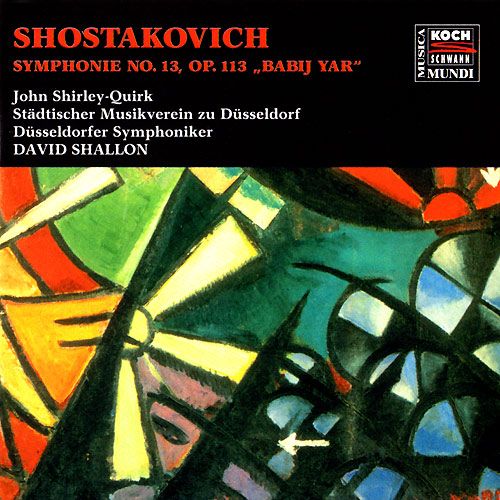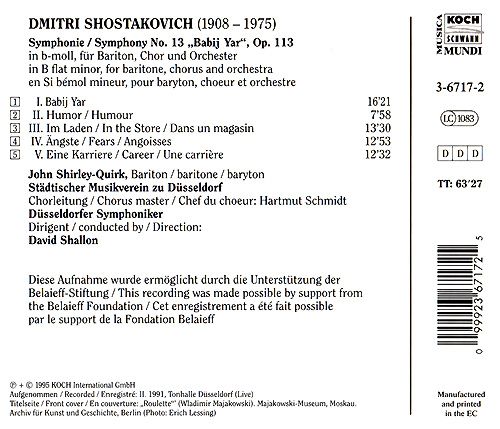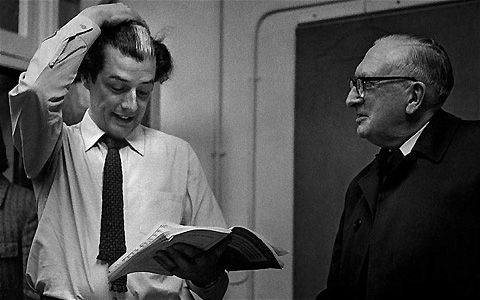wimpel69
11-27-2014, 12:15 PM
EAC-FLAC link below. This is my own rip. Complete artwork,
LOG and CUE files included. Do not share. Buy the original!
Please leave a "Like" or "Thank you" if you enjoyed this!
The death of Josef Stalin on March 5, 1953, ushered in an era of freedom for Soviet artists. But, oddly
enough, for nearly a decade following the dictator's passing, Dmitri Shostakovich, one of the chief
targets of Soviet censors in the past, wrote nothing of a radical or adventurous nature. In 1962, however,
he broke out of his conservative shell and composed his Symphony No.13, whose expressive language
is deeper and more uncompromising than any of his then-recent compositions. Only the unwieldy
Symphony No.4, whose belated premiere took place in 1961, 25 years after its completion,
is as challenging and substantive.
Even before the Symphony No.13's premiere, Shostakovich was in trouble with the Khrushchev
regime over it, though not, however, because of his music, but rather because of the texts he chose to
set. The work uses five poems by Evgeny Yevtushenko, and it was the first of these in particular, "Babi Yar,"
from which the symphony derives its subtitle, that created the controversy. It tells of oppression of
the Jews in Russia, an injustice Soviets felt the need to deny.
Over the objections of government officials, the premiere of the symphony took place in December
1962. It was a success, but pressures mounted to suppress or modify the work and a second performance
had to be canceled. Bowing at last to the wishes of authorities, Yevtushenko and Shostakovich allowed
the texts to be attenuated. Another performance took place, with the textual changes, after which
the work disappeared from Soviet concert halls for nearly three years.
The Symphony No. 13 is made up of five movements, each having a subtitle pertaining to a
Yevtushenko poem: Adagio ("Babi Yar"), Allegretto ("Humor"), Adagio ("In the store"), Largo
("Fears"), and Allegretto ("A career"). The chorus sings in unison or octaves throughout, except
for a passage near the end of the third movement. The orchestral forces are sizeable, but
Shostakovich's scoring tends to be sparing throughout, although there are outbursts of considerable
power in several places.
The first movement is dark and dramatic, morbid and harsh. This bleak panel, with the bass soloist
prominent throughout much of its duration, is an atmospheric and powerful setting of
Yevtushenko's texts. The second movement is a Scherzo, and its "Humor" is often tart and brash.
The last three movements are continuous. The text of "In the store" praises the ordinary working
woman. Shostakovich's music is subdued and dark throughout most of the movement, painting a
bleak picture of life (which Soviet officials also could not have found much to their liking). The
riveting climax in this section comes when the chorus sings (about women), "To shortchange them
is shameful...." The austere and dark fourth movement deals with fears, as the chorus starts off
whispering the word, effectively summoning a fearful atmosphere. The last movement, which offers
text praising those with integrity in their careers, begins with an attractive, slightly sad waltz,
although the mood throughout is brighter than in any previous panel. The ending is quiet, with
the waltz turning gossamer, almost mystical.
In the last two decades of the twentieth century, this symphony gained considerable popularity
both in the concert hall and on recordings. A typical performance of it lasts from about an hour
to nearly 70 minutes.

Music Composed by
Dmitri Shostakovich
Played by the
D�sseldorfer Symphoniker
With
John Shirley-Quirk (baritone)
And the
St�dtischer Musikverein zu D�sseldorf
Conducted by
David Shallon

"This is my favorite recording of the great 'Babi Yar'. John Shirley-Quirk sings the score with an
unbridled reach of passion and musicality. He and conductor Shallon cast the symphony with a
liturgical pallor that gives the mighty thing cohesion and a strange calm. The Dusseldorf Symphony
is recorded beautifully. Shallon's musicianship is front and center - he's a superb center of calm.
It shines in his work. The reason for this recording is of course Shirley-Quirk's audacious, heartbreaking,
utterly musicianly singing of a great score, a great symphony. The Dusseldorf players are elegant in
the long singing passages of Im Laden, even witty. Shallon sets them loose to soar with the great
baritone in the performance of a lifetime. This is a great recording. (Interestingly, I find the few
'live noises' actually enhance the listening experience.)"
Amazon Reviewer

John Shirley-Quirk (pictured with William Walton).
Download Link - https://mega.co.nz/#!fNITVDIZ!ZgVw1pAfLd0-zpzbh1wTs6Sho40VGl89HIp2TYG7ih4
Source: Koch Schwann CD, 1995 (my rip!)
Format: FLAC(RAR), DDD Stereo, Level: -5
File Size: 303 MB (incl. artwork, booklet, log & cue)
Enjoy! Don't share! Buy the origina! Please leave a "Like" or "Thank you" if you enjoyed this! :)
LOG and CUE files included. Do not share. Buy the original!
Please leave a "Like" or "Thank you" if you enjoyed this!
The death of Josef Stalin on March 5, 1953, ushered in an era of freedom for Soviet artists. But, oddly
enough, for nearly a decade following the dictator's passing, Dmitri Shostakovich, one of the chief
targets of Soviet censors in the past, wrote nothing of a radical or adventurous nature. In 1962, however,
he broke out of his conservative shell and composed his Symphony No.13, whose expressive language
is deeper and more uncompromising than any of his then-recent compositions. Only the unwieldy
Symphony No.4, whose belated premiere took place in 1961, 25 years after its completion,
is as challenging and substantive.
Even before the Symphony No.13's premiere, Shostakovich was in trouble with the Khrushchev
regime over it, though not, however, because of his music, but rather because of the texts he chose to
set. The work uses five poems by Evgeny Yevtushenko, and it was the first of these in particular, "Babi Yar,"
from which the symphony derives its subtitle, that created the controversy. It tells of oppression of
the Jews in Russia, an injustice Soviets felt the need to deny.
Over the objections of government officials, the premiere of the symphony took place in December
1962. It was a success, but pressures mounted to suppress or modify the work and a second performance
had to be canceled. Bowing at last to the wishes of authorities, Yevtushenko and Shostakovich allowed
the texts to be attenuated. Another performance took place, with the textual changes, after which
the work disappeared from Soviet concert halls for nearly three years.
The Symphony No. 13 is made up of five movements, each having a subtitle pertaining to a
Yevtushenko poem: Adagio ("Babi Yar"), Allegretto ("Humor"), Adagio ("In the store"), Largo
("Fears"), and Allegretto ("A career"). The chorus sings in unison or octaves throughout, except
for a passage near the end of the third movement. The orchestral forces are sizeable, but
Shostakovich's scoring tends to be sparing throughout, although there are outbursts of considerable
power in several places.
The first movement is dark and dramatic, morbid and harsh. This bleak panel, with the bass soloist
prominent throughout much of its duration, is an atmospheric and powerful setting of
Yevtushenko's texts. The second movement is a Scherzo, and its "Humor" is often tart and brash.
The last three movements are continuous. The text of "In the store" praises the ordinary working
woman. Shostakovich's music is subdued and dark throughout most of the movement, painting a
bleak picture of life (which Soviet officials also could not have found much to their liking). The
riveting climax in this section comes when the chorus sings (about women), "To shortchange them
is shameful...." The austere and dark fourth movement deals with fears, as the chorus starts off
whispering the word, effectively summoning a fearful atmosphere. The last movement, which offers
text praising those with integrity in their careers, begins with an attractive, slightly sad waltz,
although the mood throughout is brighter than in any previous panel. The ending is quiet, with
the waltz turning gossamer, almost mystical.
In the last two decades of the twentieth century, this symphony gained considerable popularity
both in the concert hall and on recordings. A typical performance of it lasts from about an hour
to nearly 70 minutes.

Music Composed by
Dmitri Shostakovich
Played by the
D�sseldorfer Symphoniker
With
John Shirley-Quirk (baritone)
And the
St�dtischer Musikverein zu D�sseldorf
Conducted by
David Shallon

"This is my favorite recording of the great 'Babi Yar'. John Shirley-Quirk sings the score with an
unbridled reach of passion and musicality. He and conductor Shallon cast the symphony with a
liturgical pallor that gives the mighty thing cohesion and a strange calm. The Dusseldorf Symphony
is recorded beautifully. Shallon's musicianship is front and center - he's a superb center of calm.
It shines in his work. The reason for this recording is of course Shirley-Quirk's audacious, heartbreaking,
utterly musicianly singing of a great score, a great symphony. The Dusseldorf players are elegant in
the long singing passages of Im Laden, even witty. Shallon sets them loose to soar with the great
baritone in the performance of a lifetime. This is a great recording. (Interestingly, I find the few
'live noises' actually enhance the listening experience.)"
Amazon Reviewer

John Shirley-Quirk (pictured with William Walton).
Download Link - https://mega.co.nz/#!fNITVDIZ!ZgVw1pAfLd0-zpzbh1wTs6Sho40VGl89HIp2TYG7ih4
Source: Koch Schwann CD, 1995 (my rip!)
Format: FLAC(RAR), DDD Stereo, Level: -5
File Size: 303 MB (incl. artwork, booklet, log & cue)
Enjoy! Don't share! Buy the origina! Please leave a "Like" or "Thank you" if you enjoyed this! :)